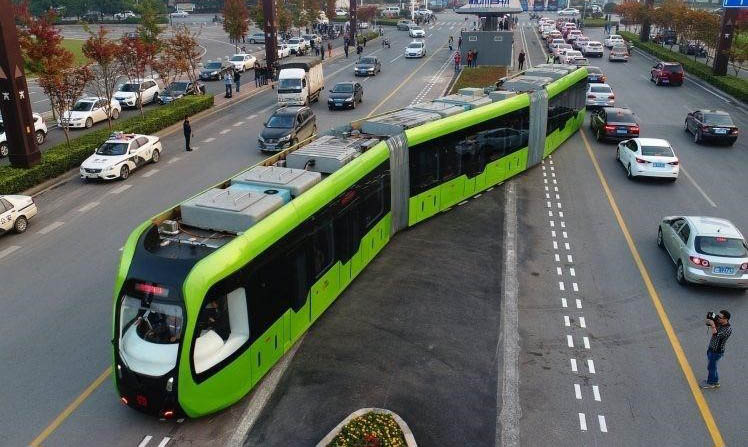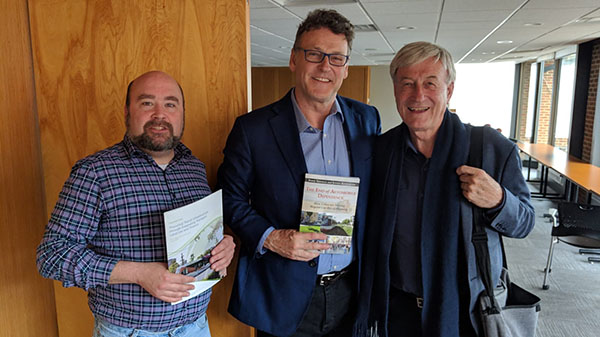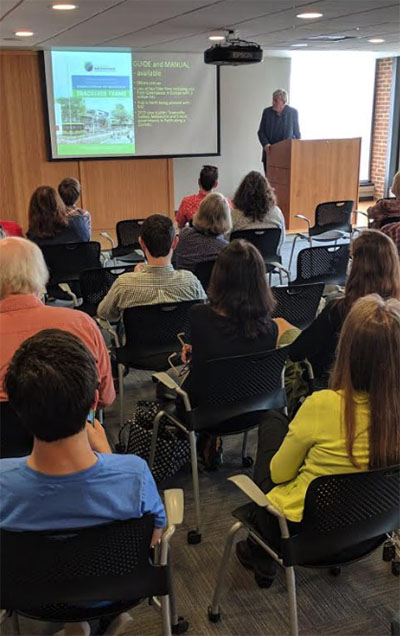This article, written by PEC field representative Sean Tubbs, covers the “Trackless Trams: A Transformative Opportunity for Charlottesville” event hosted by PEC during the Tom Tom festival on April 13, 2019.

As the population of Albemarle and Charlottesville continues to rise, a world-renowned professor of sustainability is encouraging us to imagine how a new generation of mass transportation could help create even better places to live.
“Most cities can see the problem because people sit in traffic and shake their heads and say ‘there’s got to be something better than this,’” said Peter Newman of Curtin University in Perth, Western Australia. “What kind of city do you want?”
Newman is lead author for transport at the Intergovernmental Panel on Climate Change. He was invited by The Piedmont Environmental Council to share his thoughts on “trackless trams,” autonomous vehicles that look trains but have rubber wheels. These systems use LIDAR and satellite tracking to guide themselves along a fixed path. However, unlike rail, journeys can be flexible.
“It does have a driver who can override it at any moment,” Newman said.
In the days before the event at the Tom Tom Festival, Newman appeared in Pennsylvania to promote the technology. He and his entourage met with Governor Tom Wolf as well as citizens of communities in that state.

“We met with everyday American citizens about one of our country and our world’s greatest problems, which is automobile dependence,” said Mark Cave, a local entrepreneur who went on the trip.
Newman is the author of over 20 books and 300 papers on sustainability. He wanted to appear in Charlottesville because he said the Downtown Mall is an example of a project that restored pedestrians to a city center.
“It is wonderful to look out and see this gem that you have here,” he said. “There aren’t many cities that do that and it’s something to be really proud of.”
Transit as a land use tool
Newman’s experience with the link between transportation and land use dates back to the 1970s when he moved to Fremantle, a suburb of Perth. At the time, the city center was declining due to suburban development. Many of its 19th century buildings were slated for demolition.
In response, he and others created a group called the Fremantle Society, which claimed as an early victory the halting of a new highway. They also rallied to restore passenger train service after it was cut by the state government.
“We were designed around the car, like most American cities,” Newman said. “We were going the way of automobile dependence and we’d begun to reverse it. What’s happened is that you start to build along that train line so the city center has revived.”
Newman said the urban challenge in Fremantle at the moment is how to connect the inner suburbs with the more dense urban core. He said this is common across the world in communities that have developed with the automobile in mind.
Railways allow passengers to move faster than traffic because there is less competition for space on the rails. Buses tend to travel slower than passenger vehicles because they are in the same space and also have to make several stops.
“Transport is about getting from A to B as quick as you can, but it’s about more than that because if you make a choice to put your money into rail, you will not just get better service, but you’ll get a better city because it will help you to develop centers rather than scattering land use,” Newman said.
However, building new rail lines can be prohibitively expensive. Many communities can’t afford the time or the disruption that comes with tearing up land to create new lines.
Newman said bus rapid transit is one possible solution, but added it can become ineffective because those vehicles operate in the same flow of traffic as private ones, leading to a phenomenon called “bunching.” He also said it was less likely for private development to take place around the stations.
“Knowledge-economy jobs, the really innovative creative jobs that every city wants, are being focused in these kinds of places,” Newman said. “The shopping malls are not working and the scattered land use where you commute long distances is really under threat.”
An autonomous future
As autonomous technology continues to develop, Newman said communities across the world have a choice between expanding the fleet of private automobiles or switching to an autonomous transit system.
“The new transit systems are also autonomous and it really depends on the value of city,” Newman said. “What kind of city do you want?”
Newman wants to raise awareness of trackless trams, systems that are being developed by the Chinese company CRRC. He said a major advantage of these vehicles is a stable ride. Advanced technology developed for high-speed rail helps keep the vehicle’s cabin from shaking. That’s in contrast to traditional buses which tend to sway.
“And for some people that sway makes them sick, they can’t read, but [trackless trams] have got no sway,” Newman said, shortly before displaying a video showing a toddler walking up the middle of a cabin while the tram was in motion.
Newman said the buses are half the weight of a typical diesel bus because there is no need for an engine, lessening the impact to road surfaces.
“It does need a clear way to make it work properly,” Newman said. “You have to be able to create that space and the cost doesn’t include that. That will be different in every city.”
One potential clear way would be in a highway’s shoulders. A vehicle pulled over would there not be an insurmountable obstacle.
“It is fixed, but it’s also flexible because you can override it and go around anything,” Newman said. “You can drive it.”
Linking transit and land use planning
For decades, Arlington County’s General Land Use Plan had used the Metro line to help increase residential density by building up, providing more people opportunities to live close to their commute. He suggested that Albemarle County could do something similar.
“This is a retail strip, and maybe there is a demand in the future to turn it into an urban opportunity, and an urban corridor, where there’s a lot more density,” Newman said.
The population of Albemarle County is estimated by the Weldon Cooper Center at the University of Virginia to be around 108,000. Their projections estimate that will climb to over 141,000 by 2040. To accommodate that growth, Albemarle’s Comprehensive Plan calls for additional density within the development area.
“A mixture of housing types is expected and the urban areas are to be supported by transportation systems that include interconnected streets, pedestrian paths, bicycle circulation systems, and mass transit,” reads a portion of Chapter 8 of the plan.
Newman said five local governments around Perth in Western Australia are planning for mass transit along a 30-kilometer corridor.
“The key thing drawing us together was that we needed to regenerate a number of areas along that route, and we wanted a light rail to help raise the value of the land and enable it to be unlocked,” Newman said.

He said the cost of a trackless tram would be much less expensive, making it more feasible that private developers could be enticed to pay towards the system.
“You still need government to assist it, but without needing that big capital and all of the operating costs because they can also come from the buildings,” Newman said.
Newman and his colleagues at Curtin University call this approach the Entrepreneur Rail Model.
“This is in fact how the first trams and trains were built,” Newman said. “They were all private real estate developers.”
He’s betting that if the market can provide an alternative, the trams will get passengers.
“People will get out of their cars if it’s faster and convenient and feels like its got a good ride quality, and the younger will move to live and work near those lines,” Newman said. “That’s how you regenerate your city while getting an electric transit system.”
Newman said a pilot of a trackless tram will debut in Perth this year, allowing for the local authorities to work out the regulations.
Thinking local
Newman also suggested such a vehicle could run along West Main Street in Charlottesville. Several years ago, there was a proposal to review a streetcar along the roadway but that study has remained on the shelf.
There is innovation in our own community. JAUNT is working with Perrone Robotics to build an autonomous six-person shuttle called TONY that is expected to carry passengers around Crozet. The nonprofit agency has also applied for a grant from the U.S. Department of Energy to use the program as a platform for scientific research.
Citizens and residents interested in the future of mass transportation in our community should be aware that there are opportunities at the moment.
Albemarle County has been steadily increasing their funding for Charlottesville Area Transit, an agency of the city government.
To help coordinate cooperation between the two governments, JAUNT, and the University of Virginia’s transit system, the Thomas Jefferson Planning District Commission created a “regional transit partnership” to help increase efficiency and effectiveness.”
The partnership’s meetings are open to the public and comments are taken at the start of each.
Newman said citizen involvement in transportation issues is crucial.
“Who has the power here, really?” Newman asked. “Us. You get out there and create the movement that sets the agenda.”
Questions? Reach out to Sean Tubbs >>
